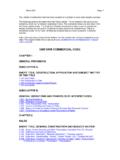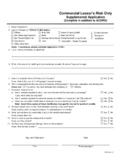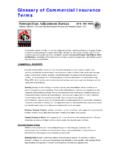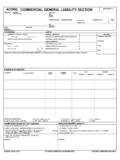Transcription of Reliability Toolkit: Commercial Practices Edition
1 Reliability toolkit : Commercial Practices Edition A Practical Guide for Commercial Products and Military Systems Under Acquisition Reform Reliability Analysis Center FOREWORD. The Reliability world is changing; no longer are the Commercial and military industrial approaches distinct. For years the military has had its advocates for the use of Commercial off-the-shelf (COTS) equipment and nondevelopmental items (NDI), but now the military use of Commercial designs is required. The June 1994 Secretary of Defense William Perry memorandum officially changed the way the military develops and acquires systems. Military standards and specifications are out (except with a waiver). and Commercial Practices are in. The " Reliability toolkit : Commercial Practices Edition " is intended to help both the Commercial and military sectors deal with developing and manufacturing reliable products in today's competitive world.
2 In 1988 Rome Laboratory used the benefit of over 30 years in the Reliability discipline to publish its RADC " Reliability Engineer's toolkit " and in 1993 a revision, "The Rome Laboratory Reliability Engineer's toolkit ," (Rome Air Development Center was renamed Rome Laboratory between the two versions). While intended for the military, these documents were best sellers and are currently in wide use by both the Commercial and military communities. Over the last 25 years, the Reliability Analysis Center, along with serving as a centralized Reliability data and information center, has worked on hundreds of Reliability projects for Commercial and military customers. Because of the vast experience base of these two organizations, it was only natural that we collaborate on a new toolkit that now stresses Commercial Reliability Practices .
3 The new toolkit concentrates on activities that have payoff, not necessarily extensive paper outputs. The toolkit recognizes that Reliability is everyone's business, so the term " Reliability engineer" doesn't appear in our title. Almost every topic of the previous toolkit has been significantly revised and numerous new subjects have been added to better represent every aspect of a product's Reliability over it's life cycle. Whether you deal with Commercial or military products, we hope that you'll find this document useful in planning and carrying-out those activities most beneficial to your products' Reliability . If you have any comments or criticisms, please let us know. Preston R. MacDiarmid JWin J. Bart Director Chief Scientist for Reliability Sciences Reliability Analysis Center Rome Laboratory Reliability toolkit : Commercial Practices Edition i PREFACE.
4 This document represents a joint effort of the Rome Laboratory and the Reliability Analysis Center. The following individuals were the primary authors: Rome Laboratory Reliability Analysis Center Seymour Morris Preston MacDiarmid Bruce Dudley David Nicholls Joseph Caroli Anthony Coppola Ned Criscimagna John Farrell The following personnel provided additional technical expertise and support: Borne Laboratory Reliability AnalysiaJSgnter Frank Born D. David Dylis Michael Seifert Robert Borgovini Edward DePalma Patrick Hetherington Kenneth Siarkiewicz Richard Sadlon Popyack Francois Chopard (Aerospatiale French Barry McKinney Exchange Engineer). Anthony Pesta Richard Hyle Peter Tabbagh (Australian AF Exchange Engineer). E. Paul Ratazzi William Bocchi Mark McCallum The Reliability Analysis Center's Jeanne Crowe 11 performed her usual magic in typing the toolkit and preparing all graphic material.
5 Comments and/or questions relative to any of the information provided can be addressed to: Seymour Morris David Nicholls Rome Laboratory/ERSR Reliability Analysis Center 525 Brooks Rd. 201 Mill St. Snffiss AFB, NY 13441-4505 Rome, NY 13440-6916. 315) 330-2951 (315) 339-7089. a-mail: e-mail: Reliability toolkit : Commercial Practices Edition iii NOTE TO toolkit READERS. At the time of authoring this toolkit , the Reliability and maintainability discipline is undergoing tremendous change. Many of the military standards and handbooks that have provided the framework and methodologies for the last 30 years are being abandoned or transitioned to dual-use documents. While these military documents have been widely used as the basis of Commercial approaches as well, the discipline will now look to non- government and international documents.
6 The authors of this toolkit recognize that the military standards and handbooks no longer carry the contractual weight that they did in the past; but because, in most cases, they contain valuable engineering information, references to them will be included for the benefit of those practitioners still able to obtain copies. iv Reliability toolkit : Commercial Practices Edition iv T A B L E OF CONTENTS. Page Section 1: The Need for Reliability Customer Expectations. 3. Market 6. Availability 11. Life Cycle 14. Liability 21. Military Needs 25. Section 2: Reliability and Maintainability Basics Reliability and Maintainability Definitions 35. Bathtub Curve. 38. Statistical Distributions 39. Reliability and Maintainability Figures-of-Merit 41. Section 3: R&M Requirements and Programs Customer R&M Requirements Performance Based Requirements 47.
7 Quantitative Reliability Requirements 51. Quantitative Maintainability Requirements 55. Quantitative Testability/Diagnostic Requirements 56. R&M Information for Proposals 59. R&M Program Requirements Product Development Phase Terminology 60. Reliability Program Elements 61. R&M Activity Priorities 66. Nondevelopmental Item (NDI) Considerations 67. Section 4: Source Selection Evaluation Criteria for Supplier Reliability and Maintainability 73. Section 5: Design Part Reliability Concerns Parts Selection, Application and Control 79. Special Part Considerations . 88. Part Stress Derating 95. Part Failure Mode/Mechanisms 98. Assembly Reliability Concerns Thermal Management 103. Interconnection 105. Power Supply Design Checklist 110. Testability Criteria (Assembly Level) 112. Equipment/System Reliability Concerns System Fault Tolerance 115.
8 Environmental Characterization 118. Critical Item Reliability 123. Reliability toolkit : Commercial Practices Edition v Software Reliability 125. Testability Criteria (System Level) 132. System Electromagnetic Guidelines 134. Mechanical Systems 136. Unique Considerations for Dormancy 142. System Maintainability 145. Product Review Questions 147. Section 6: Analysis Types of Reliability Analyses 153. Reliability Modeling 156. Reliability Prediction Methods 163. Use of Existing Reliability 168. Weibull 169. Reliability Adjustment Factors 175. Reliability Prediction of Dormant Products 177. Reliability Prediction of Mechanical Components 179. Reliability Prediction of Surface Mount Technology (SMT). 189. Reliability Prediction of Software 195. Reliability Prediction Checklist 197. Failure Modes, Effects and Criticality Analysis (FMECA).
9 198. Fault Tree Analysis (FTA) 204. Worst Case Circuit Analysis (WCCA) 211. Sneak Circuit Analysis 218. Durability 223. Maintainability Analysis 228. Testability Analysis 230. Reliability Centered Maintenance (RCM) 231. Maintainability/Testability Analysis Checklist 235. Finite Element Analysis 236. Thermal Analysis 238. Electromagnetic Analysis .. 243. Section 7: Testing Reliability Test Strategies 249. Design of Experiments 257. Accelerated Life Testing 263. Maintainability/Testability Test Strategies 269. Environmental Stress Screening (ESS) 277. Electromagnetic Testing 281. Failure Reporting and Corrective Action System (FRACAS) 284. Section 8: Production/Operation Manufacturing Variability 295. Quality and Reliability 301. Root Cause Failure Analysis 308. Lifetime Extension Assessment 315. Reliability toolkit : Commercial Practices Edition vi Section 9: Reliability Related Concepts Concurrent Engineering 325.
10 Benchmarking 329. Total Quality Management 333. I80-9000 342. Reliability Physics 345. Appendix A: Operational Parameter Translation 349. Appendix B: Example R&M Requirements for the Supplier Specification or Statement of Work 355. Appendix C: Warranties 365. Appendix D: Example Electronic Design Guidelines 377. Appendix E: Parts Count Reliability Prediction 391. Appendix F: Reliability Demonstration Testing 407. Appendix G: Reliability Growth Testing 421. Appendix H: Maintainability/Testability Testing Demonstration 427. Appendix I: Reliability and Maintainability Information Sources 433. Appendix J: R&M Standardization Documents, Rome Laboratory Technical Reports, and Reliability Analysis Center Publications 447. Appendix K: Reliability and Maintainability Education 473. Appendix L: R&M Software Sources 479.




